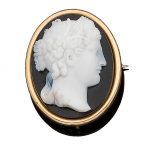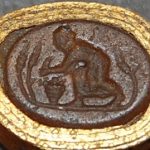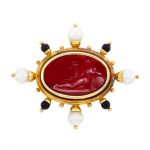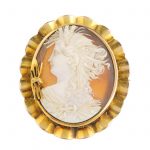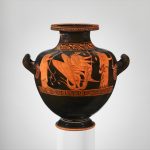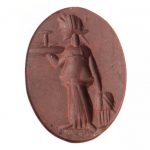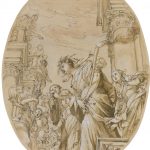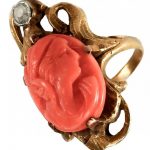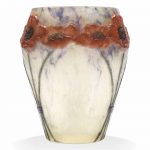Information on Demeter the Greek Goddess of Agriculture and her depictions in cameos and other art. Demeter is the goddess of the harvest and presides over grains and the fertility of the earth. Although she was most often referred to as the goddess of the harvest, she was also goddess of sacred law and the cycle of life and death. Reference: Greek Gods and Goddesses.
She was the middle daughter of Cronus and Rhea and one of the original twelve Olympians. Demeter is usually portrayed as a fully-clothed and matronly-looking woman, either enthroned and regally seated or proudly standing with an extended hand. Sometimes she is depicted riding a chariot containing her daughter Persephone, who is almost always in her vicinity. The goddesses – as they were endearingly called – even share the same attributes and symbols: scepter, cornucopia, ears of corn, a sheaf of wheat, torch, and occasionally, a crown of flowers. This can be seen in some of the cameos below. Reference: Greek Mythology
A mid 19th century hardstone cameo brooch The oval banded agate plaque carved to depict the goddess Demeter in profile, her delicately curled hair adorned with ears of wheat, collet-set within a polished border, length 4.6cm FOOTNOTES Provenance: Ex Cameo Corner, Bloomsbury.
Sold for £750 inc. premium at Bonhams in 2015
Gem of glass paste imitating sard, engraved with Demeter stooping to the right, gathering ears of corn into a basket before her. 1st Century -3rd Century
Reference: © The Trustees of the British Museum
Gold, Red Glass, Mother-of-Pearl, Cultured Pearl and Black Onyx Bead Clip-Brooch, Elizabeth Locke 18 kt., one oval intaglio ap. 20.0 x 29.0 mm., depicting the goddess Demeter, backed by mother-of-pearl, 4 pearls ap. 7.2 mm., with maker’s mark.
Pearls: whitish with rose & green hues, cleanish, small dimple on reverse of one pearl, several light scratches, very good luster. Good condition. Normal wear. 2 x 2 1/2 inches.
Sold for $1,750 (includes buyer’s premium) at Doyle New York in 2017
A mid Victorian 15ct gold cameo brooch. Carved to depict Demeter in profile, with undulating surround and side accent. Length 6.3cms. Total weight 23.3gms. CONDITION Overall condition fair. Gold addition to the side of the cameo is mostly deficient with the stems and ‘ribbon’ still remaining. Cameo in good to fair condition with glue trace to the surface. Stamped 15ct.
Sold for £180 at Fellows in 2018
Terracotta hydria: kalpis (water jar) Attributed to the Niobid Painter
Date:ca. 460–450 B.C. Culture:Greek, Attic Medium:Terracotta; red-figure
Triptolemos between Demeter and Persephone The Niobid Painter ranks with the Villa Giulia Painter as one of the preeminent artists of the second quarter of the fifth century B.C. The Niobid Painter is remembered particularly for mythological representations on large pots. Here, on a smaller scale, he depicts Triptolemos being dispatched by the goddess Demeter, the patroness of fertility and agriculture, and her daughter, Persephone, to teach the cultivation of grain to humanity. The great attraction of this legend—to the artist and the viewer—lies in the winged car that transports Triptolemos. The model here comes “loaded” with snakes.
Reference: The Metropolitan Museum of Art
Red jasper. Intaglio. Flat front and back with inward back bezel. Demeter-Ceres standing to left; body frontal and head in profile. She holds two(?) ears of corn in right hand and a tray with an unidentified object on top, in raised left arm. Very sketchily rendered. Motif situated on a partial ground line. Provenance By date unknown: Alexander Cochrane Collection; gift of Alexander Cochrane to MFA, August 1, 1918
Reference: Museum of Fine Arts Boston
Attributed to Giovanni Stefano Danedi, called Montalto TREVIGLIO 1608 – 1689 MILAN DEMETER SEARCHING FOR HER DAUGHTER, PERSEPHONE Pen and brown ink and wash, over black chalk, heightened with white and with touches of pink wash Oval, 305 by 238 mm
Sold for 3,750 GBP at Sothebys in 2013
